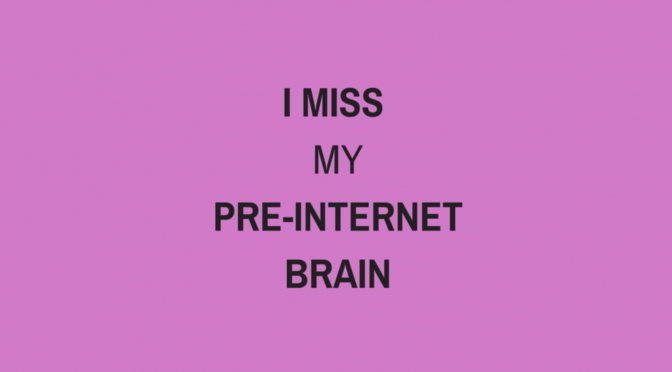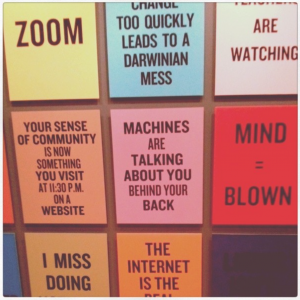“In the last few years I’ve been saying I miss my pre-Internet brain, and I think people know what I mean. And then lately I’ve been realizing I no longer even remember my pre-Internet brain. This technology has rewired my own brain, and I mean that in a genuine neurological sense, but it’s also rewired everyone else’s brain the same way.”
– Douglas Coupland
Douglas Coupland is not the only person to comment on the way the internet has impacted our thinking. Michael Wesch’s video, “Information R/evolution,” shows how digital information is different than written information. Consequently, the way we think of information is different as well.
In the digital world, hypertext it is now common cultural knowledge (Boulter, 15) and it’s uses permits us to be able to link massive amounts of information. Whereas, in the pre-digital world people were the concerned about recording information and thoughts, now the concerns are about the overwhelming amount of information which is available. There is much more information readily available than our minds are able assimilate. We are able to navigate the web and selectively choose the information that we want to “consume”. As mentioned in the ETEC540: Text Technologies: The Changing Spaces of Reading and Writing course materials, “children who grow up using ThinkTank, or similar programs, may develop the capacity to handle large amounts of information, and to structure it at an early age” (UBC, 2015).
It is notable that writing for the Internet tends to be more concise, linked, and “layered” to facilitate quick access and web surfing. Boulter and Kress both have acknowledged that visual representation is dominating over textual representation on the web (UBC, 2015). For example, “Bolter identifies a tension between textual and visual modes of representation” (UBC, 2015). Because of this many people are concerned about how some of the affordances of the web are impacting our brains by:
- the focus being on “consuming” information rather than writing it down,
- the quality of the writing which is read online, and
- the dominance of visual over written online.
Another social impact, which is an outcome of the vast information available online, is the “do-it-yourself culture” and the “maker” movement. Some people see the online information and knowledge as enabling more people to create and fix things without depending on specialists. Yet others see this as the loss of expertise and an in increase in “mass amateurization”. An expert is any field is someone who has many, many years of experience which they have been able to gain a deep knowledge about a subject. Neurologically, an expertise builds strong neural pathways which are re-enforced over time. The “do-it-yourselfers” as they gain new knowledge build new neural pathways in their brain. It’s it hard to say if one is better or worse. But the brain is definitely “wired” differently in both instances.
References
Bolter, J. D. (2001). Writing space: Computers, hypertext, and the remediation of print. Routledge
Bush, V. (1945). As we may think. The Atlantic Monthly, 176(1), 101-108. Available: http://www.theatlantic.com/doc/194507/bush
UBC (2015). Module 4: Literacy and the New Media. [Class lecture]. Retrieved from: https://connect.ubc.ca/
Blog Repost from Text & Technology
The Text & Technology blog was a collaborative effort by the ETEC540: Text Technologies: The Changing Spaces of Reading and Writing Summer 2015 students and instructor.
Source: Do You Remember Your Pre-Internet Brain? | Text & Technology

